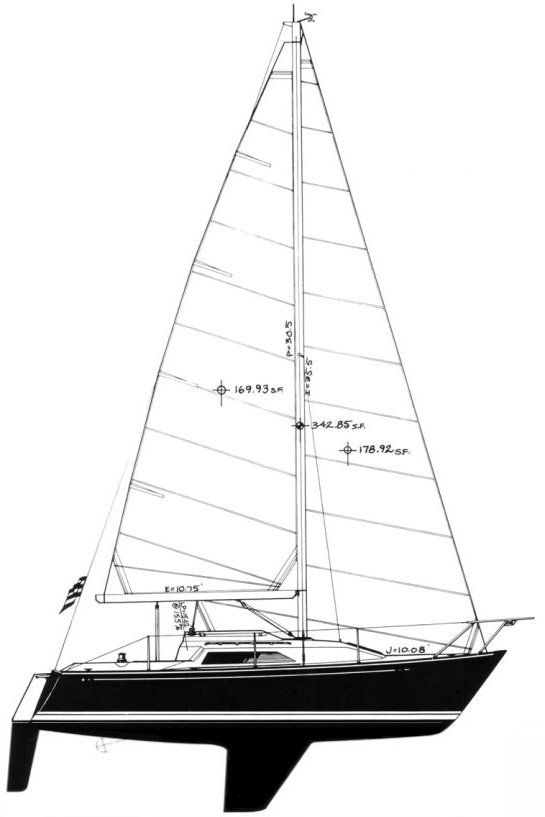
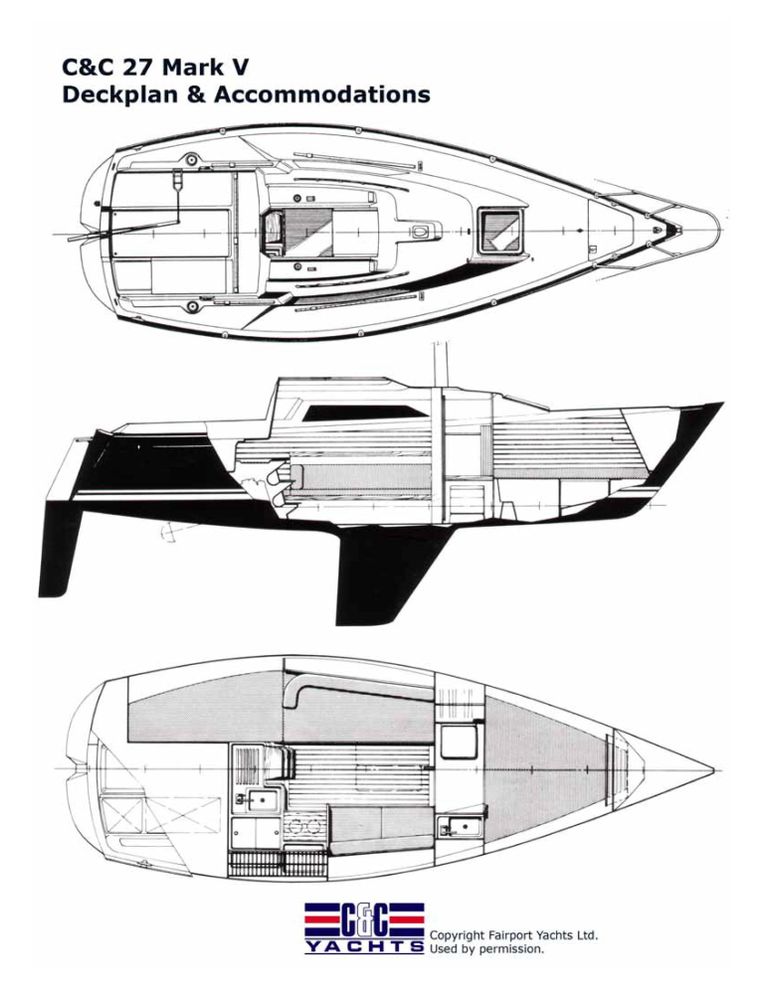
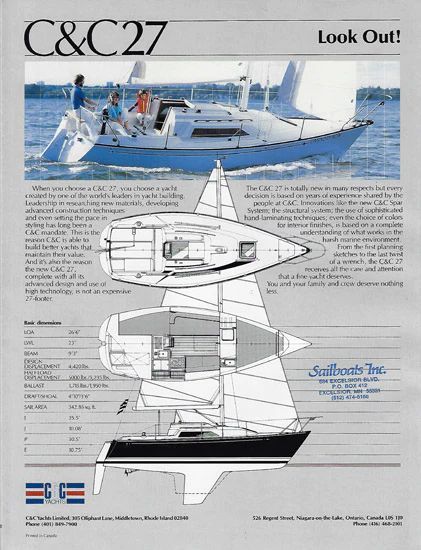
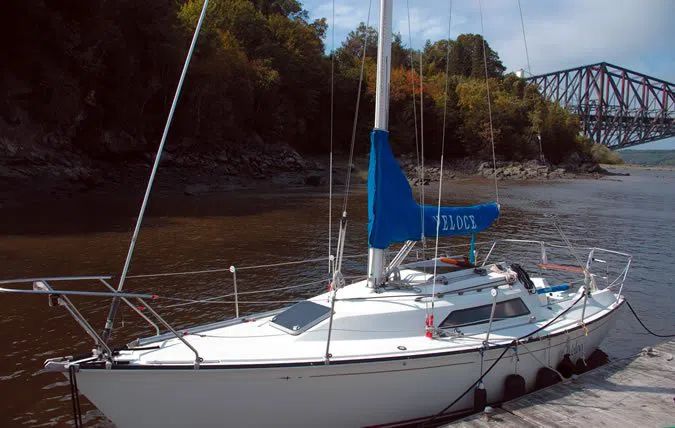
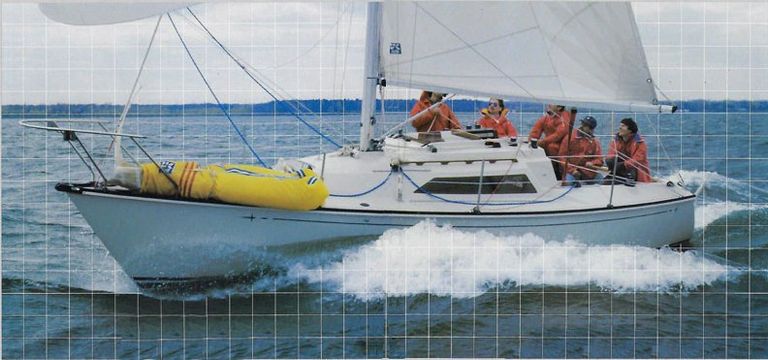
C&C 27 mk V
LOA: 26’ 5” LWL: 23'
Yacht Names
Smoke
DWG #
83-7
Designer / Draughtsman
C&C Design Group,
"Gilbert, Neil "
Year of Design
1983
Builder
C&C Yachts Limited
Notes
By the late 70's, C&C was up against a problem faced by many builders – the 27 cost the factory as much in labour and materials as larger boats, yet it couldn't be priced at a level that would maintain profitability. Also, yacht design had moved on since the original 27 had been designed; the company needed a fresher look to regain its reputation for design leadership. Moreover, measurement rules had seemingly killed the racer-cruiser form that had made C&C's name. The company needed a boat that could win races yet be suitable at least for week-ending.
Finally, the C&C Design Group (with primary responsibility given to Neil Gilbert) launched a completely new boat employing every cost-containment technique and optimized for the then-new MORC rule. Recognizing the continued appeal of the 27 brand, the company named the new boat (which is 6 inches short of 27 feet ) the new C&C 27.
http://www.cc27association.com/index.html
CC 27
By Carol Nickle and Bryan Gooderham
The first of the new C&C 27s was launched this April and we had the opportunity to take it out for a spin in mid-May. Along with the new C&C 29 introduced in 1982 (and reviewed in the November 1983 issue of Canadian Yachting), the C&C 27 represents the refurbishing of the smaller end of the line of C&C racer/cruisers. Although it measures 26 feet, six inches overall, the new boat is intended to replace the C&C 25. In describing its strategy, C&C Yachts says, "The new 27 is larger, much sleeker and more attractive, much more modern in design, and advanced in material and construction techniques, compared to the 25."
In developing the new 27, C&C sought to appeal to a wide range of the younger middle class, "including new buyers and people moving into either their first real yacht or their first C&C." The result is a comfortable, sound, middle of the road design, but it doesn't quite have the sparkle of flair and luxury that we associate with yachts from C&C. Mind you, its base price of $28,950 is also pleasantly atypical of C&C's reputation for pricing at the high end of the range.
The 27's features, designed to meet the needs of as broad a group of the small keelboat market as possible, are offered in a pleasing boat at a moderate price. CC 27 2 The main elements of the C&C 27’s galley are molded in one piece with rounded edges for easy cleaning. All lockers and drawings have positive latching mechanisms. The main saloon is pleasing and comfortable, with a cleverly designed folding table mounted on the bulkhead. In recognition of the fact that 90 per cent of prospective owners will probably want to cruise their boats, the 27 has been designed with a relatively high freeboard, an artfully streamlined cabin house and a wide beam, all of which serve to enhance interior volume. However, the C&C Design Group has not overlooked the racing ambitions of its clientele. The 27's fin keel draws four feet, 10 inches, and its flat bilges lead back to the gently reversed transom and the transom-mounted deep spade rudder. The 27 has an exceptionally tall masthead rig, with its tip some 34 feet above deck level. The tall foretriangle and the high-aspect-ratio main provide lots of sail area for its relatively low displacement of 4,420 pounds.
We sailed the 27 in a 10 to 12 knot breeze with mildly lumpy seas left over from the previous day's blow. We found the boat a pleasure to sail light on the helm and quick to respond. The boat accelerates well, as expected with its tall rig and large sail area. However, even in relatively light air we judged the 27 to be moderately tender, heeling over as the breeze freshened. The tiller steering supplied with the 27 is comfortable and suitable for this size boat, although wheel steering is an option. With the tiller, the boat can easily be steered from the cockpit seats or, in heavier conditions, from a comfortable perch along the outside curve of the cockpit coaming.
For cruising, cockpit seating is roomy enough for up to three adults, but it could be crowded with the four or five needed for racing. The deck layout is designed for easy handling by two people, with halyards led aft to the cockpit. The mainsheet traveler is located directly aft of the companionway, which is mildly inconvenient for cruising and other long passages. Nonetheless, given the size and configuration of the boat, it is the logical place to sheet the mainsail, and as such any minor inconvenience can be easily ignored.
The 27 has a special new mast section that incorporates an internal spinnaker car track along its forward edge. Neil Gilbert of the C&C Design Group informed us that the 27 mast will come equipped with a tabernacle for easy raising and lowering of the deck-stepped spar. Standard stainless steel rigging includes a split backstay and a midstay. Optional extras for the keen racer include tackle to adjust backstay and midstay tension and a grooved forestay foil. The 27 brings a new development to the classic C&C toe rail and hull-deck flange. It features an out-turned hulldeck joint incorporating a vinyl rubrail that comes in replaceable sections (without this feature C&C was forced to remove the deck to install a new rubrail), but doesn't have the characteristic C&C slotted toe rail. In addition, the 27 features sturdy synthetic stanchion bases and deck cleats, another new development for C&C. Similarly, a molded synthetic bow casting with an integrated roller for easy deployment of the anchor has been fabricated. These high-strength plastic parts serve to reduce weight and cost of construction, helping to keep the C&C 27 within reach of the mid-market boat buyer. We did observe that the bow pulpit design, with just a single tubular frame encircling the bow of the boat, leaves a wide, unprotected space where a missed step could result in the foredeck crew slipping overboard. We would prefer to see a more closed-in structure to provide a real safeguard in heavy weather.
The interior of the C&C 27 is surprisingly roomy for a yacht of its length. The generous beam and five-foot, 10 inch headroom provide substantial interior space. The cabin is largely finished in a practical cream-colored fiberglass liner, accented by warm teak woodwork. The underside of key deck fittings are accessible through removable sections of headliner attached with unobtrusive Velcro fastenings a clever and practical treatment. Two ample windows on either side of the trunk make the cabin pleasantly light, and ventilation flows through a forward hatch in the V-berth area. The interior lines are generally simple and uncluttered, making good use of modern materials. The open shelves with low teak fiddles behind the settee berths contribute to this clean-lined effect, but we think that at least a small area committed to more structured stowage (extra fiddles or a locker) would be appreciated in a seaway. The V berth forward (like all other berths on the boat) is a generous six feet, four-inches long with a forward shelf and further stowage under the berth. The V berth is separated from the head compartment by a vinyl accordion curtain which, while not providing the last word in privacy, at least gives a substantive feeling of separation. The area immediately aft of the V berth incorporates the head and hanging locker. Instead of the usual arrangement of head to port and hanging locker to starboard, the hanging locker is located outboard behind the head on the port side. The locker and head are separated by another vinyl accordion curtain. Our test indicated that this arrangement is lacking in lateral support, especially when the boat is heeled over heavily to port! The standard head is a self-contained unit, but we would expect anyone planning to live aboard to upgrade to the optional marine toilet with a holding tank for about $400. The main saloon is pleasing and comfortable, with a cleverly designed folding table mounted on the bulkhead. The settee to port converts to a double berth; not a unique idea, but one that is executed with a twist. The solid back rest flips around and over, and is strapped in place on the cabin sole beside the settee to widen it into the double berth. This maneuver demands a minimum of crew in the cabin during its execution, and we wonder if C&C couldn't have come up with something a little less cumbersome. Aft of the port settee berth is a comfortably spacious quarterberth with two nicely finished dry stowage bins underneath. CC 27 3 Tiller Steering comfortable and suitable for a boat this size. When cruising, the cockpit is roomy enough for three adults. To starboard the galley area shows the traditional C&C quality and finish. There is a good stainless alcohol stove (we would choose the propane option for any real cooking) and a generous sized, fully insulated icebox. Regrettably the sink is too shallow for going to sea; an unfortunate result, Gilbert reports, of a change of specification in a supplier's product. All lockers and drawers have positive latching mechanisms and the main elements of the galley area are molded in one piece with rounded edges for easy cleaning.
The 27, produced at C&C's Niagara and Rhode Island plants, exhibits the high-quality construction we expect from Canada's largest boatbuilder. The hull is a single unit of hand-laid molded fiberglass and the deck is balsa-cored fiberglass reinforced with plywood under such high-stress areas as winches. There are seacocks and double hose clamps on all plumbing. The boat's single battery is stowed out of the way aft of the engine, but the breaker panel is conveniently located below the companionway with spare connections for an additional optional battery. While club racers and day sailors might forego the optional diesel engine, cruisers of the C&C 27 will probably choose to install it despite a $4,900 price tag for the engine and associated hardware. Located under the cockpit floor, the engine can be reached by removing the companionway steps and also through the starboard cockpit locker. C&C has produced a very serviceable yacht in the market's small keelboat category. Its racing performance can't be foretold at the point of writing, but Gilbert is keenly involved in the Lake Ontario MORC fleet aboard the demonstration model Smoke. Watch for it in the standings.
For the cruising sailor, the C&C 27 offers a satisfying combination of space, sailing performance and popular interior features, executed in a quality fashion at a reasonable price.
Carol Nickle is an independent financial consultant. Bryan Gooderham Yacht Services and a member of the crew of the Sorc and Admiral’s Cup Racer, Amazing Grace. A roomy performer with wide appeal.
Specifications: Sail
LOA 25 – 30 Ft
Waterline 20 – 25 Ft
Beam > - 15 Ft
Displacement 4,420 Lbs
Ballast 1,715 Lbs
Draft > - 15 Ft
Berths 5 Tanks:
Water 15 Gal Fuel 10 Gal Holding 10 Gal (Optional Marine toilet)
Engine Yanmar One Cylinder 7.5 hp Diesel (Optional)
Sail Area 342 Ft2
Ratings:
MORC 21.2
PHRF 170 – 177
Originally Published in Canadian Yachting August 1984 Issue.
Number Built
280
Boat Brochure
https://boatbrochure.com/products/c-c-27-mark-v-brochure
Web Links
https://www.facebook.com/groups/MKVowners/?ref=share
All rights reserved. Motion Designs Limited
© 2022
We need your consent to load the translations
We use a third-party service to translate the website content that may collect data about your activity. Please review the details in the privacy policy and accept the service to view the translations.